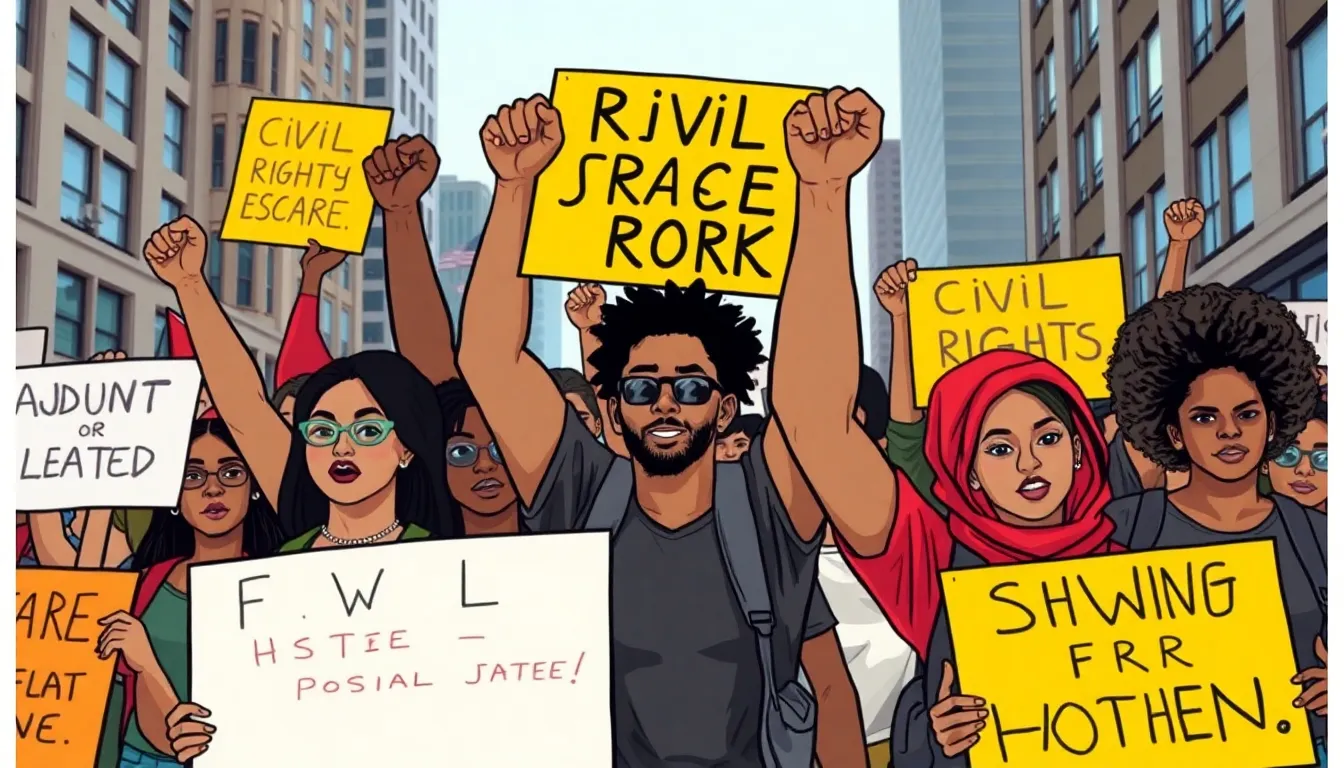Table of Contents
TogglePolitical movements have shaped societies for centuries, often sparking change faster than a cat on a hot tin roof. From grassroots campaigns to global uprisings, these movements are the lifeblood of democracy, proving that when people unite, they can challenge the status quo—sometimes with more passion than a toddler throwing a tantrum.
But what drives these movements? Is it a burning desire for justice or just a really good meme? As we dive into the world of political movements, we’ll explore the motivations behind them, the strategies that make them effective, and the impact they have on our daily lives. Buckle up; it’s going to be a wild ride through the ups and downs of collective action.
Overview of Political Movements
Political movements encompass various organized efforts that seek to promote, resist, or transform specific social or political changes. These movements can manifest on local, national, or global scales, impacting communities while shaping policy. Activism lies at the heart of such movements, engaging individuals through protests, campaigns, and advocacy.
Grassroots initiatives often emerge from community-based efforts, demonstrating the collective power of ordinary citizens. In contrast, national movements may appeal to broader audiences, leveraging media and technology to amplify their messages. Global movements unite diverse groups across borders, highlighting shared causes like climate change and human rights.
Movements typically arise from urgent social issues, including inequality, justice, or environmental concerns. Economic disparities frequently fuel activism, pushing marginalized communities to demand equitable treatment. Strategies employed vary, from peaceful demonstrations to direct actions, reflecting the mobilization tactics that resonate with participants.
Historical examples illustrate the profound impact of political movements. The Civil Rights Movement in the United States served as a catalyst for racial equality, while the Arab Spring showcased the demand for democratic governance across the Middle East. Elections often shift in response to influential movements, influencing legislative agendas and public discourse.
Understanding the complexities of political movements reveals their power to effect change. Motivations behind these movements include systemic injustice and the desire for reform. Through collective action and sustained efforts, political movements contribute significantly to the evolution of society, echoing the ongoing struggle for equity and justice.
Historical Context

Political movements have deep roots in history, often emerging in response to social injustices and pressing issues. These movements shape political landscapes and drive societal change.
Key Political Movements in History
The Civil Rights Movement played a crucial role in addressing racial inequality in the United States during the 1950s and 1960s. Women’s Suffrage Movement successfully fought for women’s voting rights, culminating in the 19th Amendment in 1920. Labor movements, particularly in the early 20th century, sought to improve working conditions and established labor rights. Anti-Apartheid Movement in South Africa mobilized against racial segregation, leading to the end of apartheid in the 1990s. Environmental movements emerged in response to climate change, advocating for sustainability and policy reforms. Each of these movements left a significant mark on their respective societies, influencing laws and social norms.
Influential Figures
Martin Luther King Jr. served as a prominent leader of the Civil Rights Movement, inspiring millions through his commitment to nonviolent protest. Susan B. Anthony became a key figure in the Women’s Suffrage Movement, dedicating her life to securing women’s rights. Cesar Chavez advocated for farmworkers’ rights, organizing strikes and boycotts that highlighted labor exploitation. Nelson Mandela led efforts against apartheid, fostering international support for justice in South Africa. Greta Thunberg represents today’s youth in climate activism, calling for urgent action on environmental issues. Each figure exemplifies the passion and dedication of those who championed social change through political movements.
Types of Political Movements
Political movements take various forms, influencing change across multiple dimensions. Each type reflects distinct objectives and methods of engagement.
Social Movements
Social movements advocate for specific societal changes. They often spring from grassroots initiatives, focusing on issues like civil rights, gender equality, and economic justice. Collective participation plays a vital role, as individuals unite to challenge inequalities. Historical campaigns, such as the Women’s Suffrage Movement, exemplify how organized efforts can secure crucial rights. Furthermore, social movements adapt to contemporary challenges, making them relevant in today’s landscape. Activists use innovative strategies, integrating social media to mobilize support and raise awareness. Consequently, the impact of social movements resonates deeply within communities, contributing to ongoing dialogues about social justice and reform.
Environmental Movements
Environmental movements focus on promoting ecological sustainability and addressing climate change. Activists within these movements emphasize the urgency of preserving natural ecosystems and combating pollution. Groups often organize protests and awareness campaigns to highlight environmental crises. Historical examples, such as Earth Day, illustrate the growing global recognition of environmental issues. Significant organizations like Greenpeace and the Sierra Club work tirelessly to advocate for policy changes. Collaborations between local communities and global entities unite diverse voices for a common cause. Engaging young activists, figures like Greta Thunberg inspire collective action, driving home the importance of urgent environmental stewardship. Environmental movements thus underscore the necessity of protecting the planet for future generations.
Modern Political Movements
Modern political movements serve as powerful catalysts for social and political change. They address pressing issues while inspiring individuals to engage in collective action.
Case Studies
Historically significant movements illustrate the breadth and depth of activism. The Civil Rights Movement sought to dismantle racial segregation in the United States, featuring leaders like Martin Luther King Jr. In South Africa, the Anti-Apartheid Movement fought against systemic racial oppression, with Nelson Mandela as a prominent figure. Women’s Suffrage Movement emerged in the early 20th century, securing voting rights through persistent advocacy. Contemporary movements such as Black Lives Matter stress racial equality and police reform, highlighting ongoing societal struggles. Additionally, climate activism, led by figures like Greta Thunberg, focuses on urgent environmental concerns, mobilizing youth worldwide.
Impact on Society
Political movements profoundly impact societal dynamics and shape public policy. They push for legislative changes addressing systemic injustices, influencing laws and regulations. Activism raises awareness, driving conversations around critical issues like inequality, climate change, and human rights. Movements can alter public opinion, prompting shifts in attitudes and norms. These campaigns often inspire grassroots initiatives, creating local organizations that work towards systemic change. Activists advocate for marginalized communities, amplifying voices that traditional structures often overlook. Through collective efforts, political movements foster more inclusive societies and contribute to the pursuit of justice and equity.
Challenges Faced by Political Movements
Political movements encounter various challenges that can hinder their effectiveness. Repression from governments often threatens activists, leading to risks such as arrest or violence. Resources may also be limited, affecting outreach efforts and financial sustainability. Organizational unity presents another challenge, as diverse groups may disagree on strategies or goals.
External factors, including media portrayal and public perception, can significantly impact movement progress. Misinformation spread through social media may distort narratives, creating confusion among supporters. Additionally, the presence of counter-movements can divert attention and resources away from core objectives.
Mobilizing grassroots support often proves difficult in heavy urban environments. Urban populations may struggle to engage fully due to a lack of community ties or trust in organizations. Rural areas, conversely, may face limited access to information and resources, further complicating mobilization efforts.
Compromise among differing factions within a movement can also create obstacles. Allies in one area may not align with the priorities of others, leading to fragmented missions. Building consensus while remaining agile in response to changing circumstances is crucial for success.
Legal barriers frequently pose hurdles for political movements. Strict laws about protests and demonstrations can restrict activities, necessitating careful planning. Activists also confront backlash from law enforcement, especially in regions with aggressive policing tactics.
Finally, movements face the challenge of sustaining momentum over time. Initial enthusiasm may wane, making it essential to keep supporters engaged. Long-term strategies that adapt to evolving social dynamics are necessary for enduring impact.
Political movements remain vital in the quest for social justice and reform. They harness collective energy to challenge injustices and advocate for change. By mobilizing communities and leveraging modern strategies, these movements address urgent issues like inequality and environmental degradation.
The passion and dedication of activists drive these efforts, creating a ripple effect that influences public policy and societal norms. Despite facing significant challenges, the resilience of these movements showcases their potential to transform societies. Understanding their dynamics is essential for anyone interested in the ongoing struggle for equity and justice in today’s world.




